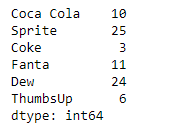Python | Pandas Series.radd()
Last Updated :
11 Feb, 2019
Pandas series is a One-dimensional ndarray with axis labels. The labels need not be unique but must be a hashable type. The object supports both integer- and label-based indexing and provides a host of methods for performing operations involving the index.
Pandas Series.radd() function perform the addition of series and other, element-wise. The operation is equivalent to other + series, but with support to substitute a fill_value for missing data in one of the inputs.
Syntax: Series.radd(other, level=None, fill_value=None, axis=0)
Parameter :
other : Series or scalar value
fill_value : Fill existing missing (NaN) value
level : Broadcast across a level,
Returns : result : Series
Example #1: Use Series.radd() function to perform the addition of a scalar with the given series object.
import pandas as pd
sr = pd.Series([10, 25, 3, 11, 24, 6])
index_ = ['Coca Cola', 'Sprite', 'Coke', 'Fanta', 'Dew', 'ThumbsUp']
sr.index = index_
print(sr)
|
Output :

Now we will use Series.radd() function to perform the addition of scalar with the series.
result = sr.radd(other = 25)
print(result)
|
Output :

As we can see in the output, the Series.radd() function has returned the result of addition of the given scalar with the series object.
Example #2: Use Series.radd() function to perform the floating division of a scalar with the given series object. The given series object contains some missing values.
import pandas as pd
sr = pd.Series([19.5, 16.8, None, 22.78, None, 20.124, None, 18.1002, None])
print(sr)
|
Output :

Now we will use Series.radd() function to perform the addition of scalar with the series.
result = sr.radd(other = 25, fill_value = 100)
print(result)
|
Output :

As we can see in the output, the Series.radd() function has returned the result of addition of the given scalar with the series object. Notice it has first substituted 100 at the place of missing values in the Series object.
Please Login to comment...